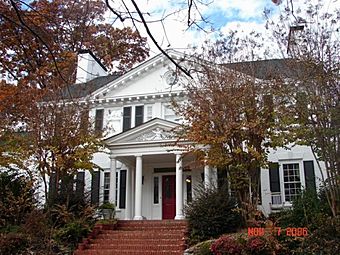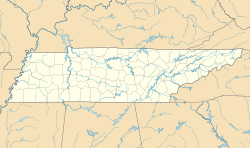Aquone facts for kids
Quick facts for kids |
|
|
Aquone
|
|
 |
|
| Location | 110 Barberry Rd Johnson City, Tennessee |
|---|---|
| Area | 3.3 acres (1.3 ha) |
| Built | 1925 |
| Architect | Leland Cardwell |
| Architectural style | Colonial Revival |
| NRHP reference No. | 93001199 |
| Added to NRHP | November 4, 1993 |
Aquone (pronounced uh-KWAN-nee) is a special house in Johnson City, Tennessee. It was once the home of Samuel Cole Williams, a famous judge and historian from Tennessee. This historic house is officially recognized and listed on the National Register of Historic Places.
What is Aquone?
Aquone is a beautiful brick house built in 1925. It has 2-1/2 stories and is designed in the Colonial Revival style. This style looks back to the grand homes of America's early days. A Johnson City architect named Leland Cardwell designed the house. He based his design on an old mansion from Maryland built in 1748.
Where is Aquone Located?
The house sits on a 3.6-acre piece of land. It is located between Roan Street and U.S. Highway 11E. Trees and a terraced lawn hide the house from these busy roads. When it was built, the house was just outside the city limits of Johnson City.
Inside Aquone House
The inside of Aquone is set up with a "center hall plan." This means there is a main entrance hall and a stairway in the middle. On one side of the hall is a large living room. On the other side is a big dining room. Both of these rooms have fireplaces. Their designs are inspired by the Georgian architecture style.
One special part of the house is its library. This room is one and a half stories tall. People say it was designed to look like the study of Sir Walter Scott. He was a famous writer who lived in Scotland. His study was at his home called Abbotsford House. The library also has a fireplace with a Georgian design.
What Does "Aquone" Mean?
The name Aquone is believed to come from the Cherokee language. It is said to mean "resting place." This name fits well for a home where a famous person lived in retirement.



